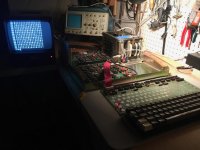ef1j95
Experienced Member
I had to share a hard-won victory getting this Sol-20 up and running. I'll post repair notes to my site soon. It involved a few iterations of power supply, PC board, and keyboard troubleshooting.
Next up is refurbishing the keyboard, a topic of much discussion on the board. I'm planning to punch out my own foam pads and was wondering what recommendations were out there for particular foam products? What thickness and foam density work best? I was going to try a lighter weather-seal type foam. Also: the keyboard is the type without the pad clips and the foam inserts are held in with an adhesive membrane.

Next up is refurbishing the keyboard, a topic of much discussion on the board. I'm planning to punch out my own foam pads and was wondering what recommendations were out there for particular foam products? What thickness and foam density work best? I was going to try a lighter weather-seal type foam. Also: the keyboard is the type without the pad clips and the foam inserts are held in with an adhesive membrane.


